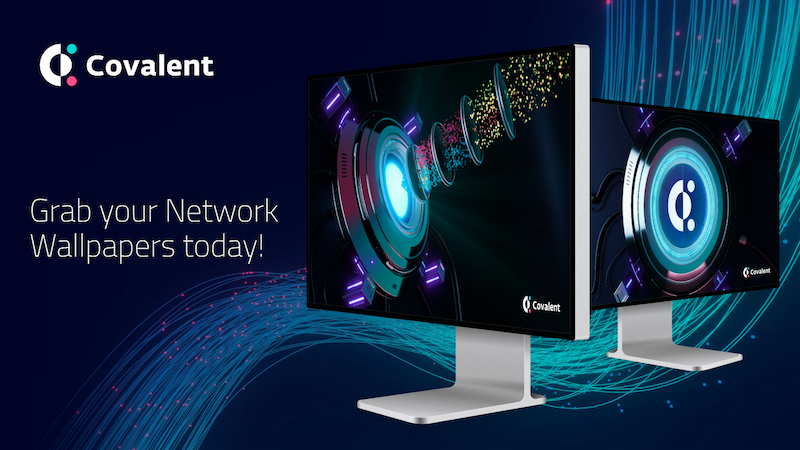TL;DR:
- Covalent is excited to ship 4 brand new products:
- a new whitepaper specification for the "Block Specimen", a novel invention to securely extract data from blockchains with cryptographic proofs
- an open-source reference implementation of the Block Specimen (a set of patches atop the popular Ethereum client Geth)
- the Covalent Network roadmap
- a set of imagery as wallpapers to celebrate the Covalent Network progress
- To date, no one has addressed the read scalability issue in Web3. The Block Specimen presents a unified, canonical schema that can be applied across multiple blockchains.
- With the reference implementation now open-source, we expect to see broad adoption of the specification across blockchain ecosystems.
- The first phase of the Covalent Network, which includes CQT single-sided staking, is expected to go live at the end of Q1 2022.
1. Standardizing Data Provenance for Web3
Covalent is excited to finally announce and open-source the Block Specimen, a novel invention that is pivotal to the decentralized Covalent Network. The anticipated Covalent Network roadmap is also live and can be viewed on the new Covalent Network homepage.
The Block Specimen allows for securely exporting blockchain data
In short, the Block Specimen is a technical specification designed to eradicate the read scalability issues that plague blockchains. The specification was defined and revised over multiple years of building with blockchain technology internally at Covalent. The Block Specimen ensures that data can be asynchronously exported from a blockchain client in a distributed system securely via a proof-based system.
For the complete overview of the Block Specimen, check out the whitepaper [here].(https://www.datocms-assets.com/86369/1670768534-block-specimen-whitepaper-v1-2.pdf)
If you want to examine the code behind it and adapt it for your ecosystem, the code is completely open-source and now available on Github.
Quote from Felix Lutsch, Chief Commercial Officer at Chorus One
Covalent is innovating in a layer often overlooked in the blockchain space, which is data. Covalent’s block specimens are a verifiable representation of the external blockchain state and play a key part in enabling consumers of Covalent’s API to efficiently query information from different networks. We are excited to be able to enrich Covalent’s API with data from many of the over 25 networks we support as a node operator by operating a block specimen producer.
2. A Unified and Secure Data Specification
The Block Specimen patches exports data from a blockchain client into a unified, canonical schema. Hence, if the Block Specimen specification is adapted for a specific blockchain, the data behind such can be instantly accessed using the unified Covalent API. As a result, the data accessibility issue is resolved for that blockchains ecosystem, broadening use cases and improving the developer experience.
To ensure that the data Block Specimens produce is honest and secure, a proof is created for every Block Specimen. Think of a Block Specimen as a block. For every block mined, a respective Block Specimen is created. These proofs are published to the Covalent proof chain and can be compared. Thus, any deviations in the data export either accidentally or malicious will have mismatching proofs.

3. Introducing Data Composability to Web3
The data behind blockchains is open and public but increasingly siloed and fragmented. The multichain world is here and with every new blockchain, the issue of data accessibility once again surfaces. This changes with the Block Specimen.
The Block Specimen introduces data composability to Web3 by introducing a standard to the data layer. Developers, whether they are building an application that is blockchain agnostic or not, can use the unified Covalent API to retrieve data so long as the Block Specimen specification has been implemented for that blockchain.

What can be expected from such composability is a consistent developer experience across ecosystems and an increased rate of innovation in the space.
Quote from Michael Kong, Fantom CEO
“ So far, Covalent has significantly enhanced the developer experience on Fantom via their unified API. Now, it's extremely exciting to see the development of the Covalent Network well underway. It will no doubt be a staple in how users access blockchain data.
4. The JSON RPC Layer Doesn’t Cut it Anymore
Covalent is the first to present a proof-based method that overcomes the cumbersome issues of querying the JSON RPC layer.
Indexing protocols currently make use of the JSON-RPC layer to pull data from blockchains. There are a number of issues with doing so. It is slow and expensive, not to mention that for Ethereum, clients will stop storing history that’s more than 1 year old..
5. Covalent Wallpapers to celebrate the launch
We are also releasing a set of wallpapers to celebrate this launch - this is often requested by our community. Happy to oblige!
What's Next
2022 is the year of the Covalent Network. In the coming months, the first phase will go live with an initial set of whitelisted operators. Along with the block specimens being generated, CQT single-sided staking will also launch, with the opportunity for CQT token holders to secure the Covalent Network.
Join us on Jan 27 10am PT for our next community call to hear about the network launch plans.
Resources
Here are some links for further exploration:
- Join the Covalent Network as an operator
- The Covalent Network homepage with the roadmap
- The Covalent Network wallpapers
- Link to the open-source GitHub repositories - Geth patches and BSP Agent.

